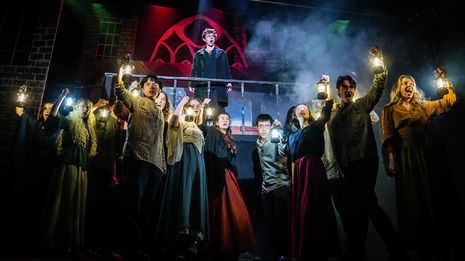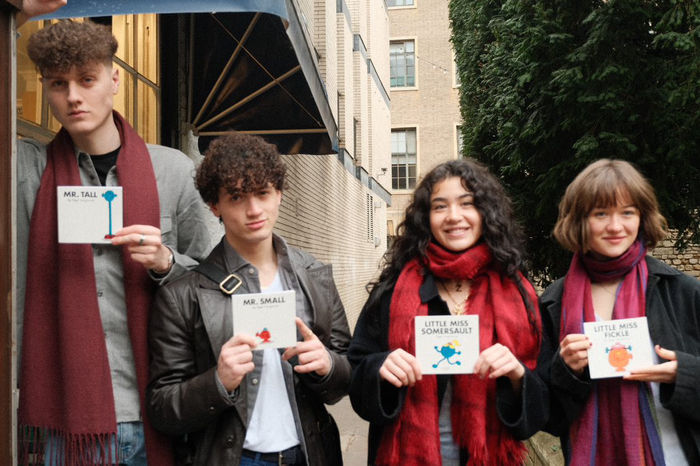Sweeney Todd is a close shave
If you’re going to do a show about a barber who kills people and a baker who puts them into pies, you can’t exactly do it half-baked

Murder, revenge, love, grief, greed - what else would you expect from a Stephen Sondheim production? Sweeney Todd: The Demon Barber of Fleet Street is a 1979 musical based on a play of the same name, which itself is based on a penny dreadful from Victorian Britain, where the story takes place. The show follows Sweeney Todd as he returns from London after serving time in Australia, seeking revenge on the men who hurt his family and had him locked up. It is there he meets Mrs. Lovett, the owner of a pie shop and eventual partner-in-crime. The show is full to the brim with vocally challenging musical numbers, exaggerated comedic relief, and oh-so many cockney accents. It’s classic Sondheim, and that makes it an exceptionally complex show to pull off.
“The show is full to the brim with vocally challenging musical numbers, exaggerated comedic relief, and oh-so many cockney accents”
Sweeney Todd is a musical which demands a great deal from its ensemble. Told through a Greek Chorus, the story relies heavily on the ensemble to fill in the narrative gaps left by the main cast. Vocally, the ensemble excelled. The rich harmonies in each chorus number were a testament to the huge amount of vocal talent on display in the production, with the particularly impressive Eleanor Worth leading the soprano section. The costumes were somewhat on the safe side, but I appreciated that going overboard with frills and corsets may have been distracting. Highly effective was Mrs. Lovett’s fancy new coat in Act Two, which gave the stage a pop of red to signify that the killing spree had begun.
Where the show unfortunately fell slightly flat was in the inconsistencies between the different members of the chorus; too often could you look on stage and see actors standing around expressionless, or joining in with the words of a song a line late. Having said that, I don’t think this was entirely the fault of the actors - often the choreography seemed too complex for the size of the stage and number of actors, leaving certain numbers looking crowded and clumsy.
“The choreography seemed too complex for the size of the stage and number of actors”
In the show’s second act, this element of clumsiness came to a head in the frankly confusing direction of the asylum scenes, which are intended to represent the climax in the musical’s plot. Instead, due to technical difficulties with microphones and sound mixing which meant the characters could not be heard over the band, the message was lost in translation. Overall, though, the band was able to keep up with the challenging score, switching from light and jovial to eerie and sinister in a moment, a feat especially well executed by the strings section.
The technical aspects of this show were a huge success, with the operational and period-accurate barber’s chair being a real marvel to observe. It was impressive for the audience every time the lever was pulled and the chair tipped up to allow the actor to slide down out of sight, and even more impressive when you find out that the chair was created entirely from scratch by the construction team. The show’s lighting was employed creatively at times, with a few highlights being the use of lanterns on stage by the ensemble, and the lights facing the stalls when the cast came off stage to interact with the audience. These moments were bursting with the energy I felt that the rest of the show so sorely needed, and delivered the classically haunting-yet-ridiculous atmosphere of Sweeney Todd.
“We saw the same Todd throughout, leaving Mrs. Lovett with something of a difficult scene partner”
The show’s titular character (played by Hugo Robijns) guides the audience through the Demon Barber’s gruesome crimes with an assured vocal performance which far exceeds the general expectation for an amateur musical. Robijns delivered a haunting rendition of ‘My Friends,’ his commanding baritone and carefully controlled vibrato perfectly capturing the brooding nature of the character. But perhaps Robijns took the ‘melancholic’ brief too far on occasion, as the performance lacked the over-the-top spirit that the rest of the show exhibits. As the show progresses and Todd’s trail of dead bodies grows longer, I would expect to see the character descend into madness and obsession. Instead, we saw the same Todd throughout, leaving Mrs. Lovett with something of a difficult scene partner to work with at times.
“It was in the hands of Freya Cowan that the show truly shone”
Speaking of Mrs. Lovett, it was in the hands of Freya Cowan that the show truly shone. In the exaggerated cockney accent the character sorely needs to succeed, Cowan was able to deliver some of the funniest lines of the show. The powerful vocal performance alone would have been enough to make Cowan the stand-out of the production, but she was a joy to watch throughout, and was a figure whom the audience could consistently rely on to give each scene exactly the energy it asked of her.
The rest of the main cast was similarly hit-or-miss, with some less remarkable performances overshadowed by unexpected stars. One such star was Annie Stedman as the Beggar Woman, whose mezzo-soprano vocals were without a doubt the most impressive of the entire show. Todd’s faux-Italian barber rival, Pirelli (Hugo Gregg), was a clear audience favourite, obvious thanks to the audible disappointment from the stalls when his character was killed off.
Sweeney Todd was a lot of fun to watch, and owes a huge amount of its success to the talent of its cast. But pitch-perfect vocals do not a perfect musical make, and the inability to be convincing in its ridiculousness left the show feeling confused in its vision. If you’re going to do a show about a barber who kills people and a baker who puts them into pies, you can’t exactly do it half-baked.
Sweeney Todd is showing at the ADC Theatre until the 23 March
 Comment / Cambridge’s tourism risks commodifying students18 April 2025
Comment / Cambridge’s tourism risks commodifying students18 April 2025 News / Varsity ChatGPT survey17 April 2025
News / Varsity ChatGPT survey17 April 2025 News / Cambridge researchers build tool to predict cancer treatment success19 April 2025
News / Cambridge researchers build tool to predict cancer treatment success19 April 2025 News / Cambridge researchers find ‘strongest evidence yet’ of life on distant exoplanet18 April 2025
News / Cambridge researchers find ‘strongest evidence yet’ of life on distant exoplanet18 April 2025 News / Greenwich House occupiers miss deadline to respond to University legal action15 April 2025
News / Greenwich House occupiers miss deadline to respond to University legal action15 April 2025






